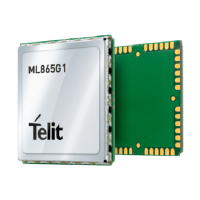ME310G1/ME910G1/ML865G1 AT Commands Reference Guide
80617ST10991A Rev.4 Page 17 of 545 2020-04-15
parameters are associated with the action, the ranges of sub parameters values that are
supported.
Action commands don’t store the values of any of their possible sub parameters.
Moreover:
The response to the Test Command (trailing =?) may be changed in the future by Telit to allow the description
of new values/functionalities.
If all the sub parameters of a parameter type command +CMD are optional, issuing AT+CMD=<CR> causes
the OK result code to be returned and the previous values of the omitted sub parameters to be retained.
2.2.1. String Type Parameters
A string, either enclosed between quotes or not, is a valid string type parameter input. According to V25.ter
space characters are ignored on the command line and may be used freely for formatting purposes, unless
they are embedded in numeric or quoted string constants; therefore a string containing a space character has
to be enclosed between quotes to be considered a valid string type parameter (e.g. typing
AT+COPS=1,0,"A1" is the same as typing AT+COPS=1,0,A1; typing AT+COPS=1,0,"A BB" is different from
typing AT+COPS=1,0,A BB).
A string is always case sensitive.
A small set of commands requires always to write the input string parameters within quotes: this is explicitly
reported in the specific descriptions.
2.2.2. Command Lines
A command line is made up of three elements: the prefix, the body and the termination character.
The command line prefix consists of the characters "AT" or "at", or, to repeat the execution of the previous
command line, the characters "A/" or "a/" or AT#/ or at#/.
The termination character may be selected by a user option (parameter S3), the default being <CR>.
The basic structures of the command line are:
• ATCMD1<CR> where AT is the command line prefix, CMD1 is the body of a basic command (nb:
the name of the command never begins with the character "+") and <CR> is the command line
terminator character
• ATCMD2=10<CR> where 10 is a sub parameter
• AT+CMD1;+CMD2=, ,10<CR> These are two examples of extended commands (nb: the name of
the command always begins with the character "+"2F2F
). They are delimited with semicolon. In the
second command the sub parameter is omitted.
• +CMD1?<CR> This is a Read command for checking current sub parameter values
• +CMD1=?<CR> This is a test command for checking possible sub parameter values
These commands might be performed in a single command line as shown below:
ATCMD1 CMD2=10+CMD1;+CMD2=, ,10;+CMD1?;+CMD1=?<CR>
anyway, it is always preferable to separate into different command lines the basic commands and the extended
commands; furthermore, it is suggested to avoid placing several action commands in the same command line,
because if one of them fails, then an error message is received but it is not possible to argue which one of
them has failed the execution.

